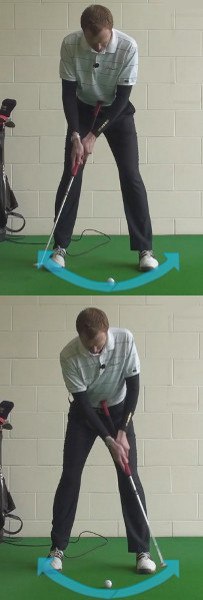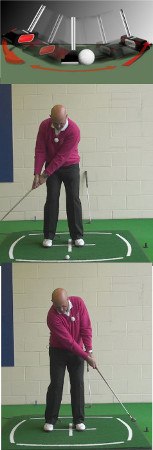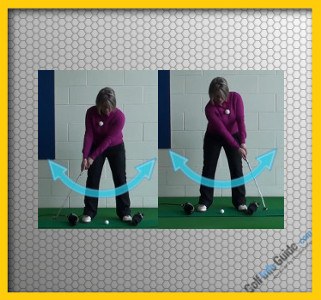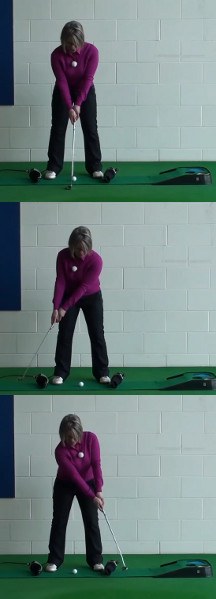
Think about the slowly swinging pendulum on a grandfather clock. Wouldn't that make a great putting stroke?
As a matter of fact, it would. And does. The so-called “pendulum stroke,” aka the “arc stroke,” has been the ideal of teachers and students for decades.
In the basic pendulum-style stroke, the golfer's hands, arms and shoulders work as a single unit, pulling the putter back and swinging it through in one harmonious motion. A pure pendulum stroke finds the butt of the grip pointing at precisely the same spot (i.e. the belly button) from address to finish. This action moves the putter head on a gentle “inside-square-inside” arc – inside the target line going back, returning to square at impact, and back inside on the follow-through.
(Note: The belly putter is designed to promote a flawless pendulum stroke, though “anchoring” putter to body will be illegal come January 1, 2016.)
The benefits of such a stroke are obvious. A perfect pendulum stroke is uniform in pace and path, from start to finish, and hits the ball squarely every time. Of course, no human is capable of making perfect stroke after perfect stroke – but that shouldn't discourage you from adopting this method.
Developing a consistent arms-and-shoulders motion is the key. However, not every arms-and-shoulders stroke follows a pendulum path. To reiterate, the end of the grip must constantly point at a fixed point directly in line with the ball to be considered a classic pendulum stroke.
The other popular putting style is called the “straight-back-straight-through” (SBST) method, exemplified by PGA Tour star Steve Stricker. While it's an arms-and-shoulders stroke, too, the path is directly back and through the ball along the target line.

Benefits of a Pendulum Putting Stroke
You are going to need a reliable putting stroke if you are going to reach your goals in the game of golf. There is simply no way to shoot good scores if you aren't putting the ball well, and there is pretty much no way to putt well without a stroke built on solid mechanics. The full swing might be more complicated than the putting stroke in terms of the number of moving parts, but you still can't afford to overlook the mechanics that make your putting stroke work. Professional golfers spend countless hours working on their putting techniques, just to give you some idea of how important this part of the game can be. Work hard on your own putting mechanics and you can expect your scores to trend in the right direction.
In this article, we are going to discuss the many benefits of a pendulum putting stoke. Even if you have heard this term before, you might not know why it is important – or even what it means exactly. We will cover this topic from top to bottom in the article that follows, and you should become a better putter thanks to this education. Even if you are already using a putting stroke which sticks to the basics of the pendulum concept, you should still be able to pick up some pointers which will help you raise the level of your performance on the greens.
Why is it so important to take time during practice to improve your putting abilities? Simple – you are going to putt on almost every single hole you play. The putter is responsible for playing the highest percentage of shots out of any club in your bag, and it's not even close. Even if you use your driver aggressively on every par four and par five, you still aren't going to use it nearly as often as your putter. The importance of putting is just an inescapable truth of this game. To play well, you have to putt well – there is no way around that fact.
Now would be a good time to highlight the need to practice your putting on a regular basis. Just as is the case with the rest of your game, you can't simply learn how to putt and then expect that skill to remain strong round after round, year after year. You need to continually practice your putting to maintain your touch and the ability to roll the ball into the hole. A period of putting practice should be built in to each and every one of your practice sessions. Before you start practicing on a given day, think about how much time you have available and divide up that time so you can work on both your full swing and your putting stroke. It is only when you combine solid technique with a commitment to practice that you will be able to enjoy excellent results.
All of the content below is based on a right-handed golfer. If you happen to play left-handed, please take a moment to reverse the directions as necessary.

What is a Pendulum Putting Stroke?
Naturally, before we get too far into the topic of how a pendulum putting stoke can help your game, we first need to discuss what is meant by the term 'pendulum putting stroke'. The name itself likely gives you some clue, but you still might not have a perfectly clear picture of how this kind of stroke works and what it looks like. In this section, we hope to clear up any confusion that may be rolling around in your mind.
A pendulum putting stroke is going to move in a similar manner to a traditional pendulum – the club is going to rock back and forth with a smooth, even tempo. There are going to be no moving parts within the stroke, other than your shoulders rocking back and forth to move the club. Specifically, you will have to keep your hands and wrists out of the action if you want to develop a true pendulum stroke. You don't need to create much power at all when putting, so there is no need to include your hands or wrists in the motion. Keep everything as quiet as possible and just rock your shoulders to produce the pendulum movement needed to roll the ball toward the hole time and time again.
If you have ever noticed that another golfer in your group has a beautiful, simple putting motion, it is likely that he or she is using the pendulum technique. Putting in this manner looks effortless in many ways, as it seems so basic and yet so effective. This is especially true on short putts, where it can look like nothing at all is happening. The putter only moves a short distance back and through, and the ball falls right into the middle of the cup – time and time again. If you are jealous of other golfers and their ability to consistently make short putts, it is about time that you followed their course of action by learning how to execute a pendulum stroke.

The Benefits
At this point, we are going to get down to business in terms of covering the title of this article. Why would you want to use a pendulum putting stoke in your game? What do you have to gain by employing this technique? We are going to answer those questions in this section. To break down the advantages in an easy-to-understand format, we have created a list below. Please review this list to understand exactly why all golfers should strongly consider using the pendulum method.
- Consistency. Above all else, it is the consistency that you can gain from this method which you should be interested in acquiring. Rolling the ball in a consistent manner over and over again is obviously desirable, as doing so is going to lead to better results round after round. Many golfers complain about being inconsistent in this game, and nowhere is that more common than on the greens. With the club rocking back and through the ball over and over again in the same fashion, you will quickly learn how to use this stroke to your advantage on the course. No one makes all of their putts, but the shortest path to consistent performance on the greens is certainly through a pendulum putting stroke.
- Distance control. By taking your hands and wrists out of the equation, you should be able to greatly improve your distance control on both short and long putts. Most golfers think about distance control as a skill they need when putting from long range, but it is actually just as important when putting from inside ten feet. No matter how far away you are, you need to give the ball the right pace to match up with the line you have selected. Since your hands and wrists contain a large number of unpredictable, hard-to-control fast twitch muscles, you will never be able to control your distance consistently when making a handsy stroke. On the other hand, your shoulders are easy to control at the same pace putt after putt. Use the pendulum method and you speed control is sure to improve, as long as you are willing to spend the necessary time on the practice green to dial in your touch just right.
- Hitting your line. Not only will a pendulum stroke help you to control your distance, but it should make it easier for you to hit your target line as well. This is really where you are going to see improvement in your short putting. Without unnecessary hand action getting in the way, the putter face will remain square to the target line for a longer period of time, and you should be able to send the ball in the intended direction over and over again. People with too much hand action in their putting stroke often miss short putts out to the right, as they aren't able to close the blade back square to the line without hitting the ball too hard. You will love the feeling of keeping the putter square to the line once you learn how to make this type of stroke. As your accuracy improves, your confidence will go up as well – and this cycle will continue until your short putting is one of the biggest strengths of your game.
- Performance under pressure. As you already know, putting under pressure is one of the great challenges in the game of golf. Where you might be able to knock in a bunch of five-footers in a row on the practice green, that task becomes more difficult when you need to do it on the course in front of your playing partners. Putting becomes especially challenging late in a good round, as you want to finish strong in order to post a good score. Unfortunately, putting strokes which feature too much hand and wrist movement tend to break down when the heat is on. The same cannot be said of pendulum putting strokes. Since there are few moving parts, there simply isn't much that can go wrong with this technique. Even if you are nervous, your stroke should still behave just as it does in practice. Using a pendulum stroke doesn't make you completely immune to the effects of pressure, but it certainly can help even out your performance.
- Confidence. There is nothing quite as powerful as confidence in the game of golf. When you believe that you can handle a certain type of shot successfully, you will usually be proven right in the end. It takes belief to play this game well, and that is certainly true when you are standing on the greens. A quality pendulum putting stroke should allow you to perform well more often than not on the greens, and your success is only going to lead to even more confidence. The great thing about being confident in your putting is you will always have that positive thought in the back of your mind, even if you are struggling on a given hole. So, for example, if you hit a couple poor shots and wind up out of position on a par five, you will still be thinking that you can save par if you can just get on the green to give yourself a chance. This belief will keep you focused even after some bad swings, because a lot of mistakes can be erased with just a single great putt.
As you can plainly see, there is plenty to like about putting with a pendulum stroke. You will likely enjoy all of the benefits listed above once you learn how to use this technique, and there may even be other positives that pop up in your game as a result. If putting has long been one of the parts of this game that gives you trouble, a brighter future on the greens could be in store thanks to the use of a classic pendulum motion.

Some Minor Drawbacks
While everything up until this point has sounded overwhelmingly positive with regard to the pendulum stoke, there are actually a few minor drawbacks that you will have to deal with along the way. These drawbacks aren't really reasons to look for another type of stroke, as the pendulum method is still the best way to go. However, you do need to be aware of the shortcoming of this technique, if only so you can find ways around these little problems.
The most common issues encountered by golfers using a pendulum stroke include the following.
- Lack of feel. While your hands and wrists are likely to make your putting stroke inconsistent, they do offer something in the way of feel for the putter head. With the rest of your clubs, you do use your hands and wrists actively, meaning you are used to the feedback they receive as the club moves. That feedback is going to largely go away with a pendulum stroke, and you might feel a bit 'robotic' as a result. The best way to overcome this hurdle is simply to practice. The more putts you roll using a pendulum motion, the more comfortable you will become with how this stroke feels. In time, you won't see this as a drawback at all, and you will be completely comfortable with the technique from start to finish.
- Distance control struggles. We listed distance control as one of the benefits of a pendulum stroke in the section above, but yet here we also see it as a drawback. How can this one point be in both places? It comes down to practice. If you don't spend much time practicing your pendulum stroke, you may struggle with distance control because there is not as much natural feel within this technique (as mentioned above). To make sure you have a great ability to roll the ball the right distance, always warm up on the putting green for a few minutes prior to starting a round. This time will help you dial in the speed for the day, and it will remind you how the ball is supposed to feel coming off the face of the putter. As long as you stay on top of this part of your game, you should be able to keep distance control in the 'positives' category with regard to the characteristics of a pendulum stroke.
- Struggles on slow greens. This is likely the main complaint that you will hear from the average golfer in terms of the pendulum stroke. When playing on slow greens, you might find that it is difficult to hit the ball hard enough to reach the hole while sticking to a true pendulum action. The pendulum stroke is not one which is designed to create a lot of speed, and it certainly does work best on fast surfaces. However, it can be used effectively on slow greens as well, as long as you use your shoulders correctly. Don't be afraid to rock your shoulders a significant distance when hitting a long putt across a slow green. Again here, your success or failure is going to come down to practice. Work on getting comfortable with long putts by using a big shoulder move and you will no longer be afraid of slow greens while using your pendulum technique.
- Difference from other short game shots. Your hands and wrists are going to be involved in the other shots you play in the short game, such as chip shots and pitches. With that in mind, you are going to need to alter your technique from around the greens when you step on the green – and that difference can be difficult for some golfers to get around. The two techniques are not going to match up perfectly, so you are going to need to work on them individually in order to reach a high level of performance.
Overall, the challenges that you will face when you opt for a pendulum stroke are relatively minor. You can certainly get past these obstacles with a bit of practice and preparation, but don't plan on everything going smoothly from start to finish. After all, golf is a hard game, and things rarely go completely as you expect.

Getting Started
When you are ready to get started with your own pendulum stroke, head to your local golf course with a putter and a few golf balls in hand. As you begin to practice, keep the following tips in mind.
- Relax your grip. Among the most important keys to making a smooth pendulum stroke is to keep your grip as relaxed as possible as you hold onto the putter. If you squeeze tightly, you are going to be tempted to involve your hands too actively in the stroke, since you will have a high degree of control over the movement of the club. By using a relaxed grip, it will be hard to move the putter with your hands and wrists, and instead the easiest way to swing the club will be to rock your shoulders.
- Keep your head still. As is the case with any kind of putting stroke, you want to keep your head perfectly still when using the pendulum method. This point is even more important with this kind of stroke, as you won't be using any hand action to move the putter back into position at the very last moment. Hold your head in the same position throughout the stroke and keep your eyes focused on the back of the golf ball until it has been sent on its way.
- Bend your knees. Too many golfers forget about the importance of the lower body in the putting stroke. Make sure you bend your knees at address when rolling the ball, and keep them bent all the way throughout the stroke. This stable platform is going to make it much easier to rock your shoulders, and the whole stroke will come together more successfully in the end.
- Relax. It is easy to get tense when putting, as you are trying to execute a delicate motion while keeping your body mostly still. Unfortunately, tension is the enemy of good putting. Rather than tightening up, do your best to relax and let the putter swing freely from side to side. Not only will relaxing your body help you to strike better putts, but you will deal with the pressure of the golf course better when you are relaxed as well.
A pendulum putting stoke can take you to new heights in this game, provided that you use it properly. Take the time to learn how to use this technique on the practice green before attempting to use it during an actual round of golf. We hope that you now have the motivation you need to implement this method into your game – and we hope you are looking forward to many years of great putts thanks to rock-solid mechanics. Good luck!





